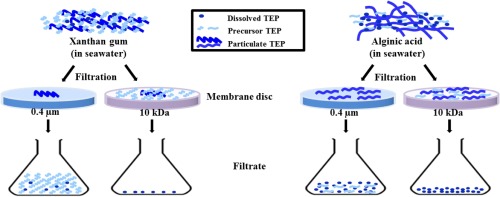Water Research ( IF 12.8 ) Pub Date : 2017-12-28 , DOI: 10.1016/j.watres.2017.12.021 Xu Li , Lucy Skillman , Dan Li , Wendell P. Ela

|
Transparent exopolymer particles (TEP) and their precursors are gel-like acidic polysaccharide particles. Both TEP precursors and TEP have been identified as causal factors in fouling of desalination and water treatment systems. For comparison between studies, it is important to accurately measure the amount and fouling capacity of both components. However, the accuracy and recovery of the currently used Alcian blue based TEP measurement of different surrogates and different size fractions are not well understood. In this study, we compared Alcian blue based TEP measurements with a total carbohydrate assay method. Three surrogates; xanthan gum, pectin and alginic acid; were evaluated at different salinities. Total carbohydrate concentrations of particulates (>0.4 μm) and their precursors (<0.4 μm, >10 kDa) varied depending on water salinity and method of recovery. As xanthan gum is the most frequently used surrogate in fouling studies, TEP concentration is expressed as xanthan gum equivalents (mg XGeq/L) in this study. At a salinity of 35 mg/L sea salt, total carbohydrate assays showed a much higher particulate TEP fraction for alginic acid (38%) compared to xanthan gum (9%) and pectin (12%). The concentrations of particulate TEP therefore may only represent ∼10% of the total mass; while precursor TEP represents ∼80% of the total TEP. This highlights the importance of reporting both particulate and precursor TEP for membrane biofouling studies. The calculated concentrations of TEP and their precursors in seawater samples are also highly dependent on type of surrogate and resulting calibration factor. A linear correlation between TEP recovery and calibration factor was demonstrated in this study for all three surrogates. The relative importance and accuracy of measurement method, particulate size, surrogate type, and recovery are described in detail in this study.
中文翻译:

用于生物污垢研究中透明外聚合物颗粒(TEP)定量的Alcian蓝和总碳水化合物测定法的比较
透明的外聚合物颗粒(TEP)及其前体是凝胶状酸性多糖颗粒。TEP前体和TEP均已被确定为淡化和水处理系统结垢的成因。为了在研究之间进行比较,准确测量两个组件的数量和结垢能力非常重要。然而,对于不同的替代物和不同的尺寸分数的当前使用的基于阿尔辛蓝的TEP测量的准确性和恢复性还没有被很好地理解。在这项研究中,我们将基于Alcian蓝的TEP测量与总碳水化合物测定方法进行了比较。三个代理人;黄原胶,果胶和海藻酸;在不同的盐度下进行了评估。微粒(> 0.4μm)及其前体(<0.4μm,> 10 kDa)随水盐度和回收方法的不同而不同。由于黄原胶是结垢研究中最常用的替代物,因此TEP浓度表示为黄原胶当量(mg XG当量/ L)。在盐度为35 mg / L的海盐下,总碳水化合物测定表明,与黄原胶(9%)和果胶(12%)相比,藻酸的颗粒TEP分数(38%)要高得多。因此,颗粒状TEP的浓度仅占总质量的〜10%;前体TEP约占总TEP的80%。这突出了报告颗粒和前体TEP对膜生物污染研究的重要性。海水样品中TEP及其前体的计算浓度也高度取决于替代物的类型和所得的校正因子。在这项研究中,对于所有三种替代物,TEP回收率与校准因子之间存在线性关系。测量方法,颗粒大小,替代类型,



























 京公网安备 11010802027423号
京公网安备 11010802027423号